Event Venue: Rome Italy
Rome is the capital of Italy; it is also the country’s largest and most populated commune and fourth-most populous city in the European Union. The Metropolitan City of Rome has a population of 4.3 million residents. The city is located in the central-western portion of the Italian Peninsula, within Lazio (Latium), along the shores of Tiber River. Vatican City is an independent country within the city boundaries of Rome, the only existing example of a country within a city: for this reason Rome has been often defined as capital of two states. It is referred to as “Roma Aeterna” (The Eternal City) and “Caput Mundi” (Capital of the World), two central notions in ancient Roman culture. One of the most important city, Rome, was founded in 753 B.C. by Romulus.
Rome is a sprawling, cosmopolitan city with nearly 3,000 years of globally influential art, architecture and culture on display. In 2005, the city received 19.5 million global visitors, up of 22.1% from 2001. Rome ranked in 2014 as the 14thmos-visited city in the world, 3rd most visited in the European Union, and the most popular tourist attraction in Italy. Its historic center is listed by UNESCO as a World Heritage Site. Monuments and museums such as the Vatican Museums and the Colosseum are among the world’s most visited tourist destinations with both locations receiving millions of tourists a year.

Key Factors of Rome, Italy
Rome, the “Eternal City,” brims with ancient history, from the Colosseum to the port of Ostia Antica to majestic Vatican City and the Sistine Chapel. Because of its history, art, architecture, and beauty – and perhaps its gelato and pasta! – Rome is one of our most popular cities.
Rome is 2,500 years older than the Republic of Italy.
Nearly 700,000 euros’ worth of coins are tossed into Rome’s Trevi Fountain each year. The proceeds are donated to Caritas to help those in need.
The Romans had built a road network of 53,000 miles by the early fourth century. Each Roman mile was about 4,800 feet and marked by a milestone, giving birth to the saying “All roads lead to Rome.”
Rome is the only city in the world that has another country inside it.
Over 500,000 gladiators and 1 million animals were killed during the Colosseum fights
Rome was the first city in the world to reach 1 million inhabitants
In Ancient Rome, only free-born men were allowed to wear togas, a sign of Roman citizenship. Women wore stolas, the female version of togas, made from linen.
The mascot of Rome is a she-wolf that cared for brothers Romulus and Remus, the mythological founders of Rome.
Rome became the capital city of unified Italy in 1870, taking the title from Florence.
Law in Rome allows cats to live without disruption in the place they were born. Wild cats can be climbing the walls of the Colosseum, and sleeping among the ruins of the Forum.
Women in ancient Rome dyed their hair with goat fat and beech wood ashes. The most popular colors were red and blond.
Julius Caesar is one of the most famous Roman leaders, and ruled as a dictator from 49 BC to 44 BC.
Romans were the first to use concrete for construction
The first ever shopping mall was built in Rome between 107 and 110 AD by Emperor Trajan. It sold a wide variety of goods and grocery items.
Rome’s first university, La Sapienza, established in 1303 AD, is the largest in Europe and the second largest in the world.
Rome has a museum dedicated entirely to pasta.
St Peter’s basilica inside Vatican City is the largest church ever constructed.
Rome is the capital of Italy, as well as one of the best-known cities in the world, so large companies choose it as a venue for numerous business events and meetings in all sectors such as pharmaceuticals, electronics, etc.
Rome is a one of the business cities in Europe. If you are looking to grow your business and network, as you enjoy some pretty good leisure activities, it is the city to beat.
Accessibility
Rome is the capital of Italy. It is a sprawling cosmopolitan city. The city comprises of nearly 3000 years of globally influential art, architecture and culture on display. Ancient ruins like the Colosseum is an important monument to depict the power of former Roman Empire. The inspiring art and architecture is the beauty of the city. Rome is known as a Romantic city and an art inspiring city. The vibrant streets here give lively nightlife to the city. Rome is known mainly for Colosseum. Colosseum is one of the Seven Wonders of the World. It is a Flavius amphi theater which was started by Emperor Vespasian in 80A.D.
Air Transport:
Rome has two main international airports, namely the Leonardo da Vinci/Fiumicino International Airport and the G.B. Pastine/Ciampino International Airport. The Leonardo da Vinci/Fiumicino International Airport is a modern and huge airport serving flights to and from all the major destinations across the globe. Late-night transfers are difficult since the buses are irregular after-hours. The G.B. Pastine/Ciampino International Airport is a relatively smaller and cheaper. It is closer to the city centre but no direct trains are available. Once reached the airport, these are the ways you can reach the city centre- From the Leonardo da Vinci/Fiumicino airport, there are two train lines: The Leonardo Express leaving every 30 minutes is the best way to reach the city centre from the airport. There are also private bus companies offering connections and you can also hire a taxi to reach the city center.
Train Transport:
Roma Termini is the main train station of Rome and offers connections to all the major destinations in Italy. Roma Tiburtina, Roma Ostiense, Roma Trastevere and Roma Tuscolana are the other stations in Rome. For long distance travel, luggage storage is available. Trenitalia offers rail service from the in-airport train station at FCO to the city center with the direct 30-minute Leonardo Express to Stazione Termini and commuter line to Stazione Trastevere. Tickets cost 8 euro for FCO-Trastevere, 14 euro for FCO-Termini 14. Children under 10 travel for free. Though Ciampino is closer to Rome, train transport into the city is less than ideal, since you’ll need to first take a bus to the nearby station and then a train to the city center.
By Car:
Rome is served by the motorway Grande Raccordo Anulare or GRA. GPS or a map is essential.
By Bus:
The bus company Eurolines operates throughout Europe. Check out their website for more information. Eurolines
By Boat:
There are two ways to reach Rome by boat- cruise ships and ferries. Ferries operate ro Barcelona, Tunis, Toulon (France), Porto-Vecchio (Corsica), Olbia and Sardinia.
Overall, London’s transportation infrastructure is extensive and diverse, ensuring that the city remains a vital gateway to the rest of the world, facilitating easy travel for both residents and tourists.



